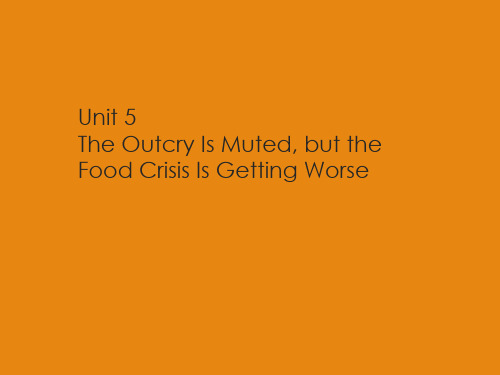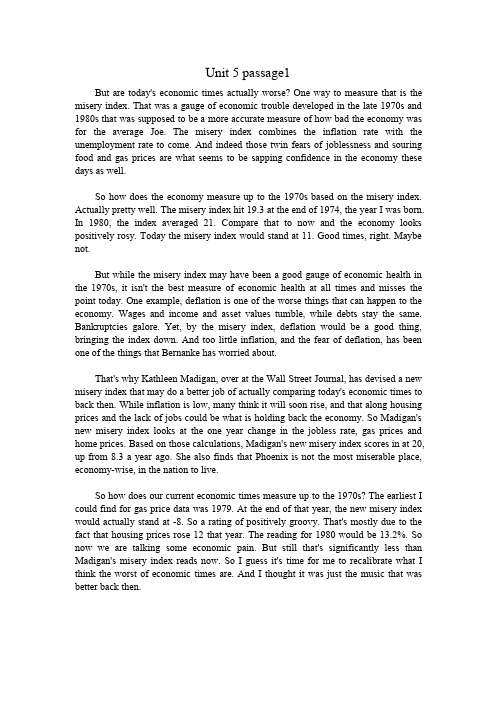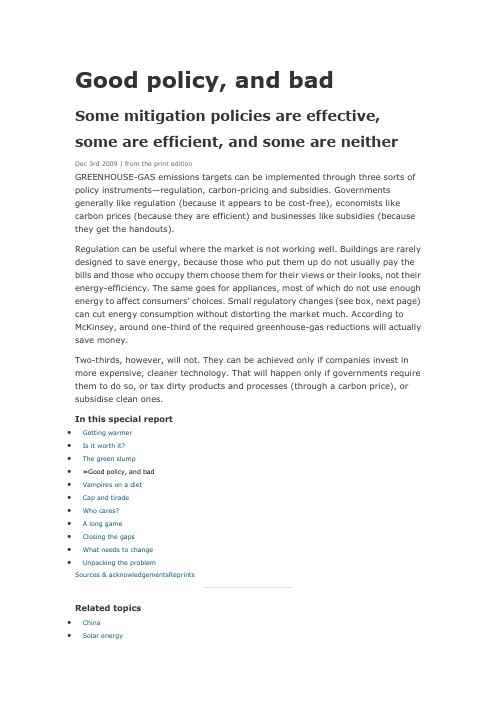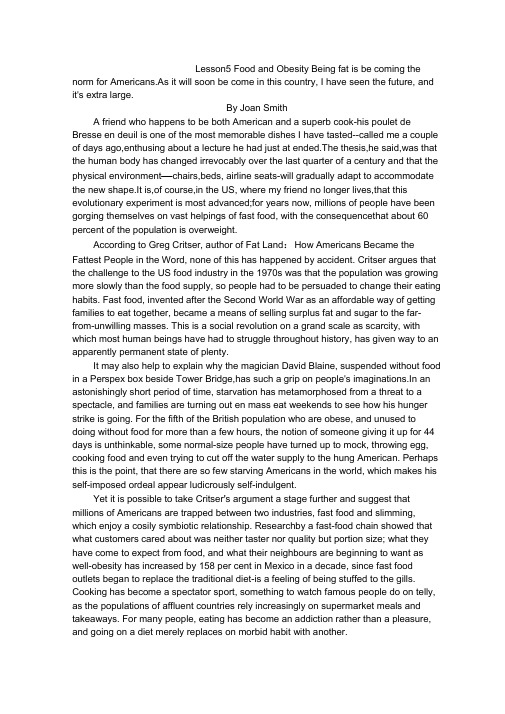英语报刊阅读教程-对外经贸大学Unit5
经贸专业英语报刊阅读教程 第一课 Good policy, and bad

Good policy, and badSome mitigation policies are effective,some are efficient, and some are neitherDec 3rd 2009 | from the print editionGREENHOUSE-GAS emissions targets can be implemented through three sorts ofpolicy instruments—regulation, carbon-pricing and subsidies. Governmentsgenerally like regulation (because it appears to be cost-free), economists likecarbon prices (because they are efficient) and businesses like subsidies (becausethey get the handouts).Regulation can be useful where the market is not working well. Buildings are rarelydesigned to save energy, because those who put them up do not usually pay thebills and those who occupy them choose them for their views or their looks, not theirenergy-efficiency. The same goes for appliances, most of which do not use enoughenergy to affect consumers' choices. Small regulatory changes (see box, next page)can cut energy consumption without distorting the market much. According toMcKinsey, around one-third of the required greenhouse-gas reductions will actuallysave money.In this special reportGetting warmerIs it worth it?The green slump»Good policy, and badVampires on a dietCap and tiradeWho cares?A long gameClosing the gapsWhat needs to changeUnpacking the problemSources & acknowledgementsReprintsRelated topics ChinaSolar energyEuropean UnionAlternative energyEuropeThe European Union's Emissions-Trading Scheme, which started up in 2005, is theonly large-scale attempt so far to set a carbon price. Under the ETS, EU countriesget national allocations which they then parcel out to over 11,500 factories in fivedirty industries. Companies can buy and sell allocations amongst themselves, andcan also buy “certified emission reductions” from developing countries to meet theircaps through Kyoto's “clean development mechanism”.Europe's flagshipThe ETS makes up the vast bulk of the global carbon market, which will be wortharound $122 billion this year. It is the principal way of financing the shift from high-to low-carbon power and industrial processes in the developing world. A wind farmin India; a methane-capture scheme for pig farms in Brazil; a forestry project inIndonesia; equipment to capture industrial gases in China—the ETS can financethem all.Although it is still young, the ETS has had some impact on emissions. According toa 2008 study at the Massachusetts Institute of Technology, in its first three years itprobably reduced them by 120m-300m tonnes, or 2-5% a year, below what theywould otherwise have been.2000.This sort of energy is expensive. The best indication of that is the carbon price thatwould be required to make investment in renewables worthwhile without subsidy.According to New Energy Finance, onshore wind energy needs a carbon price of $38,offshore of $136 and solar cells of $196. Europe's target for generating 20% of itsenergy from renewable sources therefore looks pricey. According to Richard Green,director of the Institute for Energy Research and Policy at Birmingham University,the implied marginal cost of carbon would be €129 a tonne—which suggests thatallocating such large resources to renewable-energy subsidies is, as Mr Green says,“seriously sub-optimal”.The worst example of a wasteful subsidy is America's support programme forhome-grown corn ethanol, which is coupled with tariffs on cheaper sugar-caneethanol from Brazil. The programme has raised global food prices (and thusincreased malnutrition among the world's poorest); lined the pockets of America'sfarmers; given policies to cut carbon a bad name; and cut little, if any, carbon.Solar flareThe resulting boom benefited manufacturers not just in Spain but also in Germanyand China, the biggest producers of solar cells. Last year Spain accounted for 40%of world demand. The government had planned for 400MW of solar capacity to bebuilt by2008. “There were all sorts of abuses,” says Jenny Cha se, solaranalyst at New Energy Finance. “If you connected a single module to the grid beforeSeptember 29th, your whole project got financed. So modules were changing handsfor vast sums of money.” After the deadline the market collapsed.Mr Clover is con cerned about the likely effect. “We're expecting a stampede inGlobally, New Energy Finance reckons that only $24 billion of green-stimulus moneywill be disbursed this year, with another $58 billion to follow in 2010 and a further$56 billion in。
对外经济贸易大学《金融英语阅读》教学内容与安排

《金融英语阅读》教学内容与安排本课程总体分为六大专题,每个专题都有数篇文章可用。
1: Banking IndustryChapter 1, 6, 7, 9, 20, 22, 232: Economics / moneyChapter 2, 3, 4, 5, 15, 19, 25, 26, 32, 36SystemInvestment3:Chapter 10, 13, 21, 29, 31,334:AccountingChapter 12, 24, 34, 37, 38Law5:Chapter 11, 18Others6:Chapter 16, 17, 35, 8, 14, 27, 28, 30因一学期18周总共为36课时,理想的做法是选用12课用于课堂教学,其他课程由学生课后自学,每课需要3课时。
有些准备工作和活动要求学生在课前或课下进行,以提高课堂教学效率。
所选的12课为:1、6、9、23、2、3、15、19、10、13、12、11。
时间具体安排如下:第1-2周:第1章使用课文:The Banking Industry in China第2-3周:第6章使用课文:The World Bank第4-5周:第9章使用课文:the Financial System第5-6周:第23 章使用课文:International Monetary Fund第7-8周:第2章使用课文:Politics vs. Economics第8-9周:第3章使用课文:Money第10-11周:第15章使用课文:The Macroeconomics of International Currencies第11-12周:第19章使用课文:Bretton Woods and the Gold Exchange Standard第13-14周:第10章使用课文:Assessing Investment System第14-15周:第13章使用课文:Investment Products and Services Provided by Insurers第16-17周:第12章使用课文:Pooling of Interests Accounting第17-18周:第11章使用课文:Invitation for Bids教学大纲Topic One: Banking Industry第一章The Banking Industry in China1、教学目的By the end of the chapter, students should be able to know about¾the development of the banking industry in China¾the structure of the central banking system¾the major tasks of the three policy banks in China.2、教学计划This chapter will cover 3 hours. 2 hours for the introduction of background information and explanations of terms and the texts. And the other 1 hour for discussion and practice.3、教学方法¾Translation: key sentences and terms¾Paraphrasing: major words and sentences¾Summarizing: important paragraphs¾Discussion: key issues¾Questions and answers4、背景知识The establishment of the People’s Bank of China in 1948 marked the beginning of a new chapter in the Chinese banking history. Through five decades of evolution, particularly nearly two decades of reform and opening to the outside world, China’s banking sector has entered a stage of vigorous development. With PBC as the central bank, the current banking system in China consists mainly of wholly state-owned commercial banks, which coexist and cooperate with policy banks and joint-equity commercial banks operation in their respective authorized business domains.5、重点讲解概念讲解PBCAll in one monopolistic banking systemSpecialized bankCentral bankForeign exchange reservesFiscal agentAggregate creditMonetary baseBenchmark interest rateFiscal deficitLending facilitiesPriority constructionFixed-asset investmentCommodity reservesSubsidiary第六章The World Bank1.教学目的By the end of the chapter, students should be able to know about:¾the composition of the World Bank Group;¾the importance of the World Bank Group;¾the functions of the World Bank;¾the future development of the World Bank.2.教学计划It is scheduled to take 3 hours to handle this chapter. 2 hours will be spent on explanation of the key words, phrases sentences and the features of the text, and 1 hour for class discussion and questions and answers.3.教学方法¾Translation: key sentences.¾Paraphrasing: key words and expressions.¾Explanation: new terms.¾Summarizing: key passages.¾Discussion: important issues.¾Questions and answers: interaction between teachers and students.4.背景知识The International Bank for Reconstruction and Development, usually referred to as the World Bank, was founded by the Bretton Woods Conference as an international bank to finance thereconstruction and development of member countries. Operations started in 1946. The bank is financed partly by contributions paid by member countries, partly by bond issues.5.重点讲解概念讲解hard loansubscribed capitalcompetitive biddingcredit linegrace perioddisbursed loan balances句子讲解1.Visions of imperialism, real or imagined, are less likely if the lender/donor is multinational or international.译文:无论从实际或假想的角度,一国专制的情形都不大可能出现。
经贸英语(第二版)电子教案Unit 5

In the late 1980s, China‘s goals of modernization and rapid economic (1)__g_r_o_w_t_h___
depended on the large-scale introduction of foreign (2)_t_e_c_h_n_o_l_o_g_y_. The task was to
A
1 We are interested in advanced technology and the transfer of
technology
B
我们对先进技术和技术转让都很感兴趣 。
2
The investors got back their total investments three years ahead of schedule.
B
technology transfer? Why?
2. Is it free of charge for an advanced technology? How t1980s, what did China prefer in introducing advanced
投资者提前计划三年收回了总投资 。
C
As compared with the past, the sum of direct investment
3 absorbed is 4.6 times that of the previous five years..
D
与去年相比,本年吸收的外商直接投资是前五年的4.6倍。
C
than (6)_f_i_n_is_h_e_d___,and to renovate factories through selective purchase of key
英文报刊国际商务阅读(第三版)Unit (5)

英文报刊国际商务阅读(第三版)
11. intensify: v. 加剧 Fighting around the capital has intensified in the last few hours. 最近几小时首都周边的战斗愈演愈烈。 Economic conditions intensified the pressure on industry to raise prices. 经济情况增加了企业提价的压力。
2005-2006
Nigeria
1958-1961
China major grain-producing areas of the Soviet Union
1932-1933
英文报刊国际商务阅读(第三版)
II. The following paragraph is a brief introduction of the newspaper The Guardian. Fill in the blanks with the words given. Change the form where necessary.
英文报刊国际商务阅读(第三版)
4. bailout: n. 财政援助,拯救(来自于动词词组bail out) The government has already bailed the project out once before. 政府已经对该项计划实施过一次财政拯救。 Three years of huge losses forced the bank to seek a government bailout. 三年的巨额亏损迫使该银行寻求政府援助。 The Clinton administration last winter assembled the $50 billion emergency bailout package to ease a financial crisis in Mexico. 克林顿政府去年冬天筹集了500亿美元的紧急救援资金, 以缓解墨西哥的一场金融危机。
英语报刊阅读教程-对外经贸大学Unit5

Unit5passage1But are today's economic times actually worse?One way to measure that is the misery index.That was a gauge of economic trouble developed in the late1970s and 1980s that was supposed to be a more accurate measure of how bad the economy was for the average Joe.The misery index combines the inflation rate with the unemployment rate to come.And indeed those twin fears of joblessness and souring food and gas prices are what seems to be sapping confidence in the economy these days as well.So how does the economy measure up to the1970s based on the misery index. Actually pretty well.The misery index hit19.3at the end of1974,the year I was born. In1980,the index pare that to now and the economy looks positively rosy.Today the misery index would stand at11.Good times,right.Maybe not.But while the misery index may have been a good gauge of economic health in the1970s,it isn't the best measure of economic health at all times and misses the point today.One example,deflation is one of the worse things that can happen to the economy.Wages and income and asset values tumble,while debts stay the same. Bankruptcies galore.Yet,by the misery index,deflation would be a good thing, bringing the index down.And too little inflation,and the fear of deflation,has been one of the things that Bernanke has worried about.That's why Kathleen Madigan,over at the Wall Street Journal,has devised a new misery index that may do a better job of actually comparing today's economic times to back then.While inflation is low,many think it will soon rise,and that along housing prices and the lack of jobs could be what is holding back the economy.So Madigan's new misery index looks at the one year change in the jobless rate,gas prices and home prices.Based on those calculations,Madigan's new misery index scores in at20, up from8.3a year ago.She also finds that Phoenix is not the most miserable place, economy-wise,in the nation to live.So how does our current economic times measure up to the1970s?The earliest I could find for gas price data was1979.At the end of that year,the new misery index would actually stand at-8.So a rating of positively groovy.That's mostly due to the fact that housing prices rose12that year.The reading for1980would be13.2%.So now we are talking some economic pain.But still that's significantly less than Madigan's misery index reads now.So I guess it's time for me to recalibrate what I think the worst of economic times are.And I thought it was just the music that was better back then.至少对20世纪70年代出生的我们这一代人,那十年仍然是最糟糕的时代。
经贸英语Unit 5

经贸英语
Text A: Background Information
1. Treasury bond (T- Bond) coupon rate. These bonds are not callable, but some older Treasury bonds available on the secondary market are callable within five years of the maturity date. also called U.S. Treasury bond or T-bond.
经贸英语
Text A: Background Information
2. CBS: Columbia Broadcasting System 全球第一大电视网络,全球第二大户外媒体,北美第二大广 播网络---哥伦比亚广播集团(CBS Corporation, NYSE: CBS.A and CBS),成立于1928年,是世界领先的综合性传媒集团, 受众和客户遍布美国和主要国际市场。CBS的业务涵盖从广播 到互联网几乎所有的媒体形式,包括广播电视( CBS 和 The CW : 一 家 CBS 和 华 纳 兄 弟 娱 乐 的 合 资 公 司 ) 、 有 线 电 视 ( Showtime 和 CBS College Sports Network ) 、 地 方 电 视 台 ( CBS Television Stations ) 、 电 视 节 目 制 作 发 行 ( CBS Paramount Network Television和CBS Television Distribution)、 电 台 ( CBS Radio ) 、 户 外 广 告 ( CBS Outdoor ) 、 出 版 ( Simon & Schuster )、互动媒体( CBS Interactive )、音乐 (CBS Records)、授权商品零售(CBS Consumer Products)、 录像带和DVD(CBS Home Entertainment)、商场媒体(CBS Outernet)和电视电影(CBS Films)等。
经贸专业英语报刊阅读教程 第一课 Good policy, and bad

Good policy, and badSome mitigation policies are effective, some are efficient, and some are neitherDec 3rd 2009 | from the print editionGREENHOUSE-GAS emissions targets can be implemented through three sorts of policy instruments—regulation, carbon-pricing and subsidies. Governments generally like regulation (because it appears to be cost-free), economists like carbon prices (because they are efficient) and businesses like subsidies (because they get the handouts).Regulation can be useful where the market is not working well. Buildings are rarely designed to save energy, because those who put them up do not usually pay the bills and those who occupy them choose them for their views or their looks, not their energy-efficiency. The same goes for appliances, most of which do not use enough energy to affect consumers' choices. Small regulatory changes (see box, next page) can cut energy consumption without distorting the market much. According to McKinsey, around one-third of the required greenhouse-gas reductions will actually save money.Two-thirds, however, will not. They can be achieved only if companies invest in more expensive, cleaner technology. That will happen only if governments require them to do so, or tax dirty products and processes (through a carbon price), or subsidise clean ones.In this special report•Getting warmer•Is it worth it?•The green slump•»Good policy, and bad•Vampires on a diet•Cap and tirade•Who cares?• A long game•Closing the gaps•What needs to change•Unpacking the problemSources & acknowledgementsReprintsRelated topics•China•Solar energy•European Union•Alternative energy•EuropeCarbon pricing keeps government out of management decisions and allows managers to choose between different ways of cutting carbon. According to a paper by Carolyn Fischer, of Resources for the Future, and Richard Newell, head of America's Energy Information Administration, a carbon price is around twice as efficient as a renewable portfolio standard (which requires power companies to generate a certain proportion of the power they sell from renewable sources) and about two-and-a-half times as efficient as a renewable-energy subsidy.A carbon price can be set either by a tax or through a cap-and-trade system. Europe already has such a system and America, Australia and Japan are trying to set one up. Norway and Sweden have carbon taxes and France soon will (though none of them covers much of those countries' economies). The European Commission is also now looking at a tax. Both methods have advantages and drawbacks, but tax wins out for simplicity and stability.More important than the way the price is set, though, is its level. It needs to be high enough to send an unmistakable signal to business. According to Dimitri Zenghelis, one of the authors of the Stern Review and a senior adviser to Cisco and the Grantham Research Institute, a $40 carbon price now, doubling by 2050, and combined with non-price policies such as appliance standards and R&D support, is needed to hit the 450ppm target.The European Union's Emissions-Trading Scheme, which started up in 2005, is the only large-scale attempt so far to set a carbon price. Under the ETS, EU countries get national allocations which they then parcel out to over 11,500 factories in five dirty industries. Companies can buy and sell allocations amongst themselves, and can also buy “certified emission reductions” from developing countries to meet their caps through Kyoto's “clean development mechanism”.Europe's flagshipThe ETS makes up the vast bulk of the global carbon market, which will be worth around $122 billion this year. It is the principal way of financing the shift from high- to low-carbon power and industrial processes in the developing world. A wind farm in India; a methane-capture scheme for pig farms in Brazil; a forestry project in Indonesia; equipment to capture industrial gases in China—the ETS can finance them all.Although it is still young, the ETS has had some impact on emissions. According to a 2008 study at the Massachusetts Institute of Technology, in its first three years it probably reduced them by 120m-300m tonnes, or 2-5% a year, below what they would otherwise have been.Power companies and manufacturers factor a carbon price into their investment decisions these days. A t €15 ($22) a tonne the price is high enough to induce powercompanies to switch some generation from coal to gas at the margin, but not high enough to encourage much innovation.Blame politics. The price is determined by the cap, which is set by the European Commission in consultation with member states. Initially, member states overestimated their emissions in order to get lots of permits, so the carbon price was lower than the commission had expected. For the second phase of allocations, from 2008, member states fought vigorously to get more permits than their neighbours. Some sued the commission and, in September 2009, won. The price dipped again.Thanks to a combination of recession and lack of political will, most estimates of the future level of Europe's carbon price have been revised sharply downwards this year. And if America gets a carbon price, it is unlikely to be high enough to make much difference. According to America's Environmental Protection Agency, the legislation Congress is now considering would set it at $12 a tonne in 2012, rising to $20 in 2020. That, by itself, is unlikely to encourage much new investment, so if America is to make a dent in its emissions, it will have to rely mostly on subsidies.There is an argument for some of those. Basic R&D in new energy technologies—in carbon capture and storage, for instance, which would allow the continued use of coal to generate electricity—is too risky for most companies to undertake on their own, and offers enough social benefits to deserve government support. But the subsidies now on offer go far beyond that.Governments are spending heavily on encouraging the switch to low-carbon technologies, especially wind and solar power. “These policies are not particularly efficient, but they have been quite effective,” says Guy Turner, director of carbon markets at New Energy Finance. Some 50% of new power capacity added in the EU in 2000-06 was renewable energy, compared with 29% in 1990-2000.This sort of energy is expensive. The best indication of that is the carbon price that would be required to make investment in renewables worthwhile without subsidy. According to New Energy Finance, onshore wind energy needs a carbon price of $38, offshore of $136 and solar cells of $196. Europe's target for generating 20% of its energy from renewable sources therefore looks pricey. According to Richard Green, director of the Institute for Energy Research and Policy at Birmingham University, the implied marginal cost of carbon would be €129 a tonne—which suggests that allocating such large resources to renewable-energy subsidies is, as Mr Green says, “seriously sub-optimal”.The worst example of a wasteful subsidy is America's support programme for home-grown corn ethanol, which is coupled with tariffs on cheaper sugar-cane ethanol from Brazil. The programme has raised global food prices (and thus increased malnutrition among the world's poorest); lined the pockets of America's farmers; given policies to cut carbon a bad name; and cut little, if any, carbon.Solar flareEurope has yet to devise a policy quite so disastrous, but Spain's solar subsidy comes a close second. Its feed-in tariff for solar energy, established in 2007, offered generators 44 euro cents per kilowatt-hour. Coal-fired power costs around 4 cents per kwh to generate. The tariff was supposed to be for small-scale projects, of 100kw or less; but generators found that they could get it for larger ones if they installed banks of 100kw modules next to each other.The resulting boom benefited manufacturers not just in Spain but also in Germany and China, the biggest producers of solar cells. Last year Spain accounted for 40% of world demand. The government had planned for 400MW of solar capacity to be built by 2010. In the event, 3GW was built. Panicking about the commitments it was building up, the government announced that rates would drop to 32 cents on September 29th 2008. “There were all sorts of abuses,” says Jenny Chase, solar analyst at New Energy Finance. “If you connected a single module to the g rid before September 29th, your whole project got financed. So modules were changing hands for vast sums of money.” After the deadline the market collapsed.The Spanish crash hit silicon-wafer producers, the manufacturers of equipment for solar-cell producers and the makers of cells across the world. Prices across the industry crashed by 30-40%, and solar companies' share prices fell by 50-75% in 2008, though they have picked up a bit this year. Some 20,000 jobs have been lost in the solar industry in Spain over the past year, and plenty more elsewhere.Europe's energy subsidies, unlike America's, do not include nuclear, largely because of German opposition (which may change, following Angela Merkel's recent election victory). Nuclear power is more expensive than coal and gas, but probably cheaper than most renewables—though nobody is sure, since political opposition has ensured that few plants have been built in the West in recent years. Nuclear power does, however, have the virtue of scale. For renewables a gigawatt of power is a massive amount; for nuclear power it is the basic unit.Thanks to stimulus money to combat the recession, subsidies are now flooding into the renewable-energy business faster than ever before. Governments across the world have trumpeted their stimulus packages as a way of saving the world economy and the planet at the same time. Green stimulus money globally adds up to around $163 billion, according to New Energy Finance, of which more than $100 billion is being spent in America and China. The biggest chunk, around a quarter, is going on improving energy efficiency. Grid development is next, with a fifth.The green stimulus money has been slow in coming. In America it started to flow in the second half of this year, just as the economy began to recover. Some of it has been used to extend the tax credits for wind and solar energy and to convert some of the tax-credit schemes into grants. As a result, wind developers in America now get a cheque for 30% of the cost of the project once they connect to the grid. That scheme runs out at the end of next year.Mr Clover is concerned about the likely effect. “We're expecting a stampede in 2010. The danger is that you just bring forward demand. That's been a key feature of the US market. We've already seen several subsidy cycles—very high installations followed by complete cessations of activity. All anybody wants is long-term regulatory stability.” He hopes that will come with the imposition of a federal renewable portfolio standard on generators, which would require them to sell a certain proportion of renewable electricity as part of the mix.Globally, New Energy Finance reckons that only $24 billion of green-stimulus money will be disbursed this year, with another $58 billion to follow in 2010 and a further $56 billion in 2011. So it looks as though the money will come too late to temper the recession of 2008-09, and may instead fuel another inflationary boom in a couple of years' time.。
英美报刊阅读教程中级精选本第五版端木义万lesson5FoodandObesity

Lesson5 Food and Obesity Being fat is be coming the norm for Americans.As it will soon be come in this country, I have seen the future, and it's extra large.By Joan SmithA friend who happens to be both American and a superb cook-his poulet de Bresse en deuil is one of the most memorable dishes I have tasted--called me a couple of days ago,enthusing about a lecture he had just at ended.The thesis,he said,was that the human body has changed irrevocably over the last quarter of a century and that the physical environment—chairs,beds, airline seats-will gradually adapt to accommodate the new shape.It is,of course,in the US, where my friend no longer lives,that this evolutionary experiment is most advanced;for years now, millions of people have been gorging themselves on vast helpings of fast food, with the consequencethat about 60 percent of the population is overweight.According to Greg Critser, author of Fat Land:How Americans Became the Fattest People in the Word, none of this has happened by accident. Critser argues that the challenge to the US food industry in the 1970s was that the population was growing more slowly than the food supply, so people had to be persuaded to change their eating habits. Fast food, invented after the Second World War as an affordable way of getting families to eat together, became a means of selling surplus fat and sugar to the far-from-unwilling masses. This is a social revolution on a grand scale as scarcity, with which most human beings have had to struggle throughout history, has given way to an apparently permanent state of plenty.It may also help to explain why the magician David Blaine, suspended without food in a Perspex box beside Tower Bridge,has such a grip on people's imaginations.In an astonishingly short period of time, starvation has metamorphosed from a threat to a spectacle, and families are turning out en mass eat weekends to see how his hunger strike is going. For the fifth of the British population who are obese, and unused to doing without food for more than a few hours, the notion of someone giving it up for 44 days is unthinkable, some normal-size people have turned up to mock, throwing egg, cooking food and even trying to cut off the water supply to the hung American. Perhaps this is the point, that there are so few starving Americans in the world, which makes his self-imposed ordeal appear ludicrously self-indulgent.Yet it is possible to take Critser's argument a stage further and suggest that millions of Americans are trapped between two industries, fast food and slimming, which enjoy a cosily symbiotic relationship. Researchby a fast-food chain showed that what customers cared about was neither taster nor quality but portion size; what they have come to expect from food, and what their neighbours are beginning to want as well-obesity has increased by 158 per cent in Mexico in a decade, since fast food outlets began to replace the traditional diet-is a feeling of being stuffed to the gills. Cooking has become a spectator sport, something to watch famous people do on telly, as the populations of affluent countries rely increasingly on supermarket meals and takeaways. For many people, eating has become an addiction rather than a pleasure, and going on a diet merely replaces on morbid habit with another.In the circumstances, it is not really surprising that people are confused and an gered by Bia ine, whose stunt highlights the disordered relati on to eat ing which has become habitual in Western societies. Far from being an object of derision as his body en ters ketosis, the state in which it starts to con sume itself, he should logically be the envy of all those in dividuals who are en dlessly trying Atk ing and other fashi on able diets. We are so used to heari ng people pay to get hun gry, tur ning the con diti on of starvi ng Africa ns into a Ion ged-for luxury. There is someth ing sham ing about this, and about the extent to which so many people-like Kafka' hunger artist, who was addicted to starv in g-have lost con trol of their appetites.Perhaps the thesis my frie nd described to me on the phone is correct, and houses and cars and pla nes will just have to get bigger as the huma n race-the afflue nt part of it, that is-continues to inflate itself with empty calories. Bizarrely, being fat is fast beco ming the norm for America ns, and eve n in this country it will soon be people likeme(5ft 5in and a paltry nine stone) who are the freaks. I have seen the future, and ' extra large.Pla in food moves up a classI was supposed to give a talk myself at the weeke nd, on food and class, but had to pull out becauseof an annoyin gly persiste nt throat virus. I was going to discuss Eat ing above your stati on” ,which is someth ing I lear nt to do, like many people of my gen eratio n, whe n I went to uni versity. Un til the n, I had scarcely ever eate n in a restaura nt and I had n ever tried what my family referred to as foreig n muck ”.Ever macar oni cheesewas too exotic for my pare nts, who tipped it in to the bin whe n I came home from cookery class with a Pyrex dish full of overcooked pasta and melted cheddar.Food was pla in, served on a plate with thick porti ons of gravy or custard, and the idea of helping yourself from serving dishes seemed the height of sophistication. What strikes me no w, looki ng back on that traditi onal work in g-class diet, is that it was un adve nturous but it did n 'do me ant harm. My father grew vegetables, my mother shelled peas and sliced carrots, and I don't recall anyone in my family being overweight. It s hard to eat too much whe n some one else puts the food on your plate. These days, if a work in g-class diet can be said to exist, it is surperficially much more cosmopolitan-curries, pizza, the ubiquitous Chin ese takeaway-but adapted to satisfy the British appetite for saturated fat, salt and sugar.In a curious reversal, plain food-simple grilled fish with a green salad, such as the wonderful meal I ate in Marbella in the summer-has become the province of the middle class. I am one of those lucky people who cha nged class at the right time and in the right directi on, but the effects of our eat ing habits-a sle nder elite, as millio ns of ordinary people pile on the poun ds-suggest that class divisi ons are as deep as ever.Bring on the euroI was driving back from a health farm the other day when the friend with whom I had just shared three days of massage, facials and Pilates said rather n ervously that she wan ted to ask me a questio n. I n aturally assumed that she wan ted to talk about men, underwear or the least painful way of shaving your legs, as women do when they know each other well, but it turned out to be something far more intimate. Am I, sheasked, in favour of jo ining the euro?Oh God, anything but that. Admitt ing that you fell no attachme nt to the pound, and would like to use the euro in Waitrose, is like telling your friends that you have joined a weird sect. I don't think people spend much time thinking about Gordon Brow n 'five econo mic tests, but there is a presumpti on that the British did jolly week to stay out of the eurozone when all those foreigners gave up their currencies almost two years ago. And now we're supposed to admire the Swedes for resoundingly voting No” at the weekend.I don 'thi nk I v e ever con fessed this in public before, and I suspect I won 'be in vited to any smart parties for weeks at the very least. But I really want to join the euro. And since we both came out somewhere on the M1-it was a relief, I can tell you-I now know at least one other pers on who feels the same.。
- 1、下载文档前请自行甄别文档内容的完整性,平台不提供额外的编辑、内容补充、找答案等附加服务。
- 2、"仅部分预览"的文档,不可在线预览部分如存在完整性等问题,可反馈申请退款(可完整预览的文档不适用该条件!)。
- 3、如文档侵犯您的权益,请联系客服反馈,我们会尽快为您处理(人工客服工作时间:9:00-18:30)。
Unit5passage1But are today's economic times actually worse?One way to measure that is the misery index.That was a gauge of economic trouble developed in the late1970s and 1980s that was supposed to be a more accurate measure of how bad the economy was for the average Joe.The misery index combines the inflation rate with the unemployment rate to come.And indeed those twin fears of joblessness and souring food and gas prices are what seems to be sapping confidence in the economy these days as well.So how does the economy measure up to the1970s based on the misery index. Actually pretty well.The misery index hit19.3at the end of1974,the year I was born. In1980,the index pare that to now and the economy looks positively rosy.Today the misery index would stand at11.Good times,right.Maybe not.But while the misery index may have been a good gauge of economic health in the1970s,it isn't the best measure of economic health at all times and misses the point today.One example,deflation is one of the worse things that can happen to the economy.Wages and income and asset values tumble,while debts stay the same. Bankruptcies galore.Yet,by the misery index,deflation would be a good thing, bringing the index down.And too little inflation,and the fear of deflation,has been one of the things that Bernanke has worried about.That's why Kathleen Madigan,over at the Wall Street Journal,has devised a new misery index that may do a better job of actually comparing today's economic times to back then.While inflation is low,many think it will soon rise,and that along housing prices and the lack of jobs could be what is holding back the economy.So Madigan's new misery index looks at the one year change in the jobless rate,gas prices and home prices.Based on those calculations,Madigan's new misery index scores in at20, up from8.3a year ago.She also finds that Phoenix is not the most miserable place, economy-wise,in the nation to live.So how does our current economic times measure up to the1970s?The earliest I could find for gas price data was1979.At the end of that year,the new misery index would actually stand at-8.So a rating of positively groovy.That's mostly due to the fact that housing prices rose12that year.The reading for1980would be13.2%.So now we are talking some economic pain.But still that's significantly less than Madigan's misery index reads now.So I guess it's time for me to recalibrate what I think the worst of economic times are.And I thought it was just the music that was better back then.至少对20世纪70年代出生的我们这一代人,那十年仍然是最糟糕的时代。
或许因为那时候我们只是婴儿,所以没有真正亲自体验那个时代的生活,但是通过父母的讲述以及电影《出租车司机》所反映出的逼真世界,我们了解到那时候物价和燃气价格飞涨,犯罪率急剧上升,这些都清晰地向我们展现出经济灾难的真实面目。
现在的经济状况是不是更糟糕呢?一个度量方式就是“痛苦指数”,这是20世纪七八十年代出现的测量经济困难的方法,应该可以准确度量经济对普通美国人影响的糟糕程度。
“痛苦指数”是将通货膨胀率和失业率结合起来计算而得的。
事实上,失业及食物和油价飞涨的双重恐惧好像正是削弱了我们对当前经济信心的因素。
用“痛苦指数”测量得出的经济状况符合20世纪70年代的真实情况吗?非常符合!1974年末,也就是我出生的那年,“痛苦指数”达到19.3。
1980年,平均“痛苦指数”为21。
把这些数字与现在的情况相比,当前的经济看起来相当乐观,因为现在的“痛苦指数”只有11。
经济繁荣时期,是吗?或许不是。
虽然“痛苦指数”是测量20世纪70年代经济情况健全程度的很好的方式,但它不是适合所有时代的,它对于现在的经济状况的测量就没有抓住核心。
例如,通货紧缩是当前经济中最糟糕的问题。
工资收入及资产价值暴跌,而债务却不变,这导致了大量的破产事件。
但是,用“痛苦指数”度量经济状况的话,通货紧缩反而是件好事,它会降低该指数的值。
极低的通货膨胀率加上通货紧缩的恐惧,一直是伯南克非常担心的事。
鉴于此,凯思琳。
麦迪甘在《华尔街日报》上设计了一个新的“痛苦指数”,或许能够真正地将今天和以前的经济状况进行比较。
虽然通货膨胀率低,但很多人认为它很快会上升,同时也认为制约经济的可能就是房价和失业。
因此,麦迪甘设计的新“痛苦指数”会考查一年当中失业率、油价及房价的变化。
按照麦迪甘的这种新的计算方法,现在的“痛苦指数”会达到20,一年前为8.3.她也发现,菲尼克斯不是美国经济最惨淡的地方。
那么现在的经济状况跟20世纪70年代差不多吗?我能找到的最早的油价数据是1979年的。
在那年年末计算得出的新“痛苦指数”为-8,这绝对是个极好的数据,主要是因为那年房价上涨了12个百分点。
1980年的数据为13.2%。
现在,我们谈的是经济困难问题,但是那仍然远远小于现阶段的麦迪甘“痛苦指数”。
因此,我想我该重新校准一下我心目中的经济困难时期。
我认为还是过去的乐曲更悦耳些。
Unit5passage2Weak dollar gives British tourists reason to smileA plummeting dollar is giving Britons a better reason to look across the Atlantic for their holidays than they’ve had since2009,with a steadily gaining euro making the continent a pricey option.美元飙升给英国人更好的理由,看看大西洋的假期比2009年以来,欧洲稳定增长使欧洲成为一个昂贵的选择。
Unit5passage3Wall Street is back华尔街卷土重来American investment banks dominate global finance once more.That’s not necessarily good for America美国投行再次占据全球金融主导地位,对美国未必好May11th2013|From the print editionFOR a few tense weeks in2008,as investment-bank executives huddled behind the imposing doors of the New York Federal Reserve,Wall Street seemed to be collapsing around them.Lehman Brothers filed for bankruptcy,Merrill Lynch collapsed into the arms of Bank of America.American International Group(AIG) and Citigroup had to be bailed out and the rot seemed to be spreading.Hank Paulson,the treasury secretary at the time,recalled in his memoir that:“Lose Morgan Stanley and Goldman Sachs would be next in line—if they fell thefinancial system might vaporise.”2008年投行高层挤在纽约联储局里的那几个月,华尔街摇摇欲坠。
